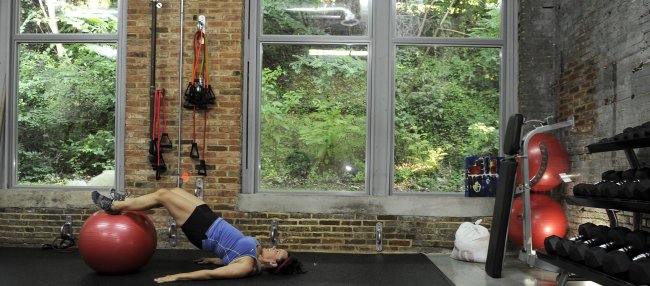It’s a Wednesday evening at the Pop Physique studio in downtown Baltimore, and a dozen women ― most clad in leggings, T-shirts and socks ― are rotating their hips while trying to hold an exercise ball between their thighs.
“Great job, guys!” says instructor Smithy Onattu, directing her students via a headset as a playlist with songs such as Lana Del Rey’s “Florida Kilos” and “Tumblr Girls” by rapper G-Eazy pumps through the art-filled space.
Over the course of an hour, the group will tackle a series of exercises: planks and push-ups, plies and other ballet moves. They’ll stretch while using bright orange straps and do demanding lower body work on yoga mats.
“Squeeze, squeeze. And pulse and pulse,” says Onattu, as the women study her and watch themselves in a full-length mirror. “Squeeze from your seat as you lift up.”
Pop Physique offers an hourlong, ballet barre-based class that draws on dance, Pilates and other disciplines.
The club is representative of a new workout space trend taking hold across the country: boutique gyms.
Boutique gyms offer fewer members and a more intimate setting than so-called big-box health clubs. They’re typically run independently rather than being corporate-owned and provide specialized targeted exercise programs.
Think barre, Pilates, yoga, boot camps, cross training and group cycling. Personalized instruction is emphasized.
“The boutique fitness facility industry has emerged as a trend in the past five years,” says Stephen Tharrett, a cofounder and principal of Club Intel, a Dallas-based brand strategy company that offers data and insight into the $22.4 billion fitness club industry.
The growth in boutique fitness can be attributed to several key cultural, sociodemographic and economic trends, according to Tharrett.
“Great job, guys!” says instructor Smithy Onattu, directing her students via a headset as a playlist with songs such as Lana Del Rey’s “Florida Kilos” and “Tumblr Girls” by rapper G-Eazy pumps through the art-filled space.
Over the course of an hour, the group will tackle a series of exercises: planks and push-ups, plies and other ballet moves. They’ll stretch while using bright orange straps and do demanding lower body work on yoga mats.
“Squeeze, squeeze. And pulse and pulse,” says Onattu, as the women study her and watch themselves in a full-length mirror. “Squeeze from your seat as you lift up.”
Pop Physique offers an hourlong, ballet barre-based class that draws on dance, Pilates and other disciplines.
The club is representative of a new workout space trend taking hold across the country: boutique gyms.
Boutique gyms offer fewer members and a more intimate setting than so-called big-box health clubs. They’re typically run independently rather than being corporate-owned and provide specialized targeted exercise programs.
Think barre, Pilates, yoga, boot camps, cross training and group cycling. Personalized instruction is emphasized.
“The boutique fitness facility industry has emerged as a trend in the past five years,” says Stephen Tharrett, a cofounder and principal of Club Intel, a Dallas-based brand strategy company that offers data and insight into the $22.4 billion fitness club industry.
The growth in boutique fitness can be attributed to several key cultural, sociodemographic and economic trends, according to Tharrett.

“One is the rise of the niche fitness consumer who is seeking a personalized fitness experience that aligns with their unique interests and needs,” he says, noting that millennials who tend to value innovation and entrepreneurship are helping to drive the momentum. “Another is the changing mind set of consumers that has moved from quantity is better to more personal is better.”
The so-called big-box fitness segment has seen increasing pressure to cut prices because of the growth of budget clubs and slower membership growth because of the presence of boutique fitness centers, according to Tharrett.
Membership revenues for the big-box market players (several calls to large chain gyms in Baltimore seeking comment for this article were not returned) have remained relatively flat the past few years, while revenues from other sources (i.e., personal training, small group training, spa services) have shown steady growth.
That growing popularity of specialized offerings has led to boutique studios such as Pop Physique, the brainchild of Jennifer Williams, a former professional ballerina and Pilates instructor, and her husband, Deric, a brand developer. The couple launched their enterprise in Los Angeles in 2008.
Local devotees have been flocking to the Baltimore franchise since its opening in the summer of 2012.
There are about 2,000 students, according to a company spokeswoman. It’s $20 for a single class, and new clients can get 30 days of unlimited classes for $100.
“It’s something different,” says Lauren Kohr, 25, of her decision to try a boutique fitness class.
A community relations staffer for a national charity, she has been coming to Pop Physique “off and on” for about six months. “It’s challenging, but the atmosphere is not intimidating.”
Amber Rose, Kohr’s friend and co-worker, appreciates the relatively small class sizes. Most important, the 28-year-old volunteer manager believes her body looks and feels better. “And it really tones the booty,” she says, laughing.
While Pop Physique has the look of a ballet studio, other boutique facilities evoke elements of a traditional gym.
Sanctuary Bodyworks opened nearly two years ago in what was formerly St. Stanislaus Church in Baltimore’s historic district.
Today, it’s a 5,000-square-foot homage to wellness, complete with stained-glass windows and a pew for seating alongside treadmills, massage tables and other equipment.
With architectural details that include soaring painted ceilings, hardwood floors and large windows that bring in abundant natural light, it’s big enough to have a big-gym vibe, yet the atmosphere is softer, more inviting.
“My goal was that it be beautifully designed, with a serene feeling,” says Brandon Hallock, who founded and owns Sanctuary Bodyworks. “We want clients to feel at peace when they come in and when they leave.”
Hallock, a buff and youthful-looking 40, holds a bachelor’s degree in exercise physiology and has 20 years of experience as a personal trainer and bodywork expert.
He rides his bike to work, and he believes in an integrated approach to fitness.
Thus, Sanctuary offers ample options: Pilates, deep-flow yoga, Zumba, acupuncture, belly dancing and Rolfing, a type of massage therapy. Soon, they plan to introduce aerial yoga with silks.
There’s no membership here, though there are dozens of regulars who come weekly and biweekly. Personal training sessions begin at $70-$80; pricing for group classes varies but one can “drop in” for as little as $16.
“I never liked the idea of going into a room full of gym clothes-clad people ― that scared me. But immediately I knew that Sanctuary was different,” says Kelly Horvath, 45, a writer and editor who has been coming to the gym since the winter of 2013. “There’s a very serene, tranquil environment here, which may seem incongruous with working out.
“It’s not chock-full of people, and the instructors are very knowledgeable about anatomy, physiology and exercising safely so you don’t get injured. That sealed it for me.”
Hallock adds that he and his team “try not to overpack classes,” and work closely with clients they train one-on-one to develop a holistic approach to their overall fitness goals.
“We’re not trying to push any particular aesthetic or a Hollywood body on anyone,” Hallock says. “I believe in sustainable fitness and training that’s part of your lifestyle.”
And it seems a growing number of people are in line in with Hallock’s credo. More Americans are heading to health clubs than ever before, according to experts.
In the United States, more than 62.1 million Americans used a health club in 2013 (up 5 percent, from 50.2 million, in 2012), based on a study conducted by the International Health, Racquet & Sports-club Association, an industry trade group.
Among the many choices available these days are “full-service centers providing a resort-like experience, family-friendly centers, small studios with expert trainers, convenient 24-hour gyms, women-only clubs and sport-specific facilities,“ according to a statement from the IHRSA.
The results also showed that nearly 53 million Americans were card-carrying members of more than 32,000 health clubs nationwide. On average, members frequented a fitness center for 102.9 days in 2013, an all-time high.
By Donna M. Owens
(The Baltimore Sun)
-
Articles by Korea Herald









![[Today’s K-pop] BTS pop-up event to come to Seoul](http://res.heraldm.com/phpwas/restmb_idxmake.php?idx=644&simg=/content/image/2024/04/17/20240417050734_0.jpg&u=)
![[Graphic News] More Koreans say they plan long-distance trips this year](http://res.heraldm.com/phpwas/restmb_idxmake.php?idx=644&simg=/content/image/2024/04/17/20240417050828_0.gif&u=)







![[KH Explains] Hyundai's full hybrid edge to pay off amid slow transition to pure EVs](http://res.heraldm.com/phpwas/restmb_idxmake.php?idx=652&simg=/content/image/2024/04/18/20240418050645_0.jpg&u=20240419100350)

